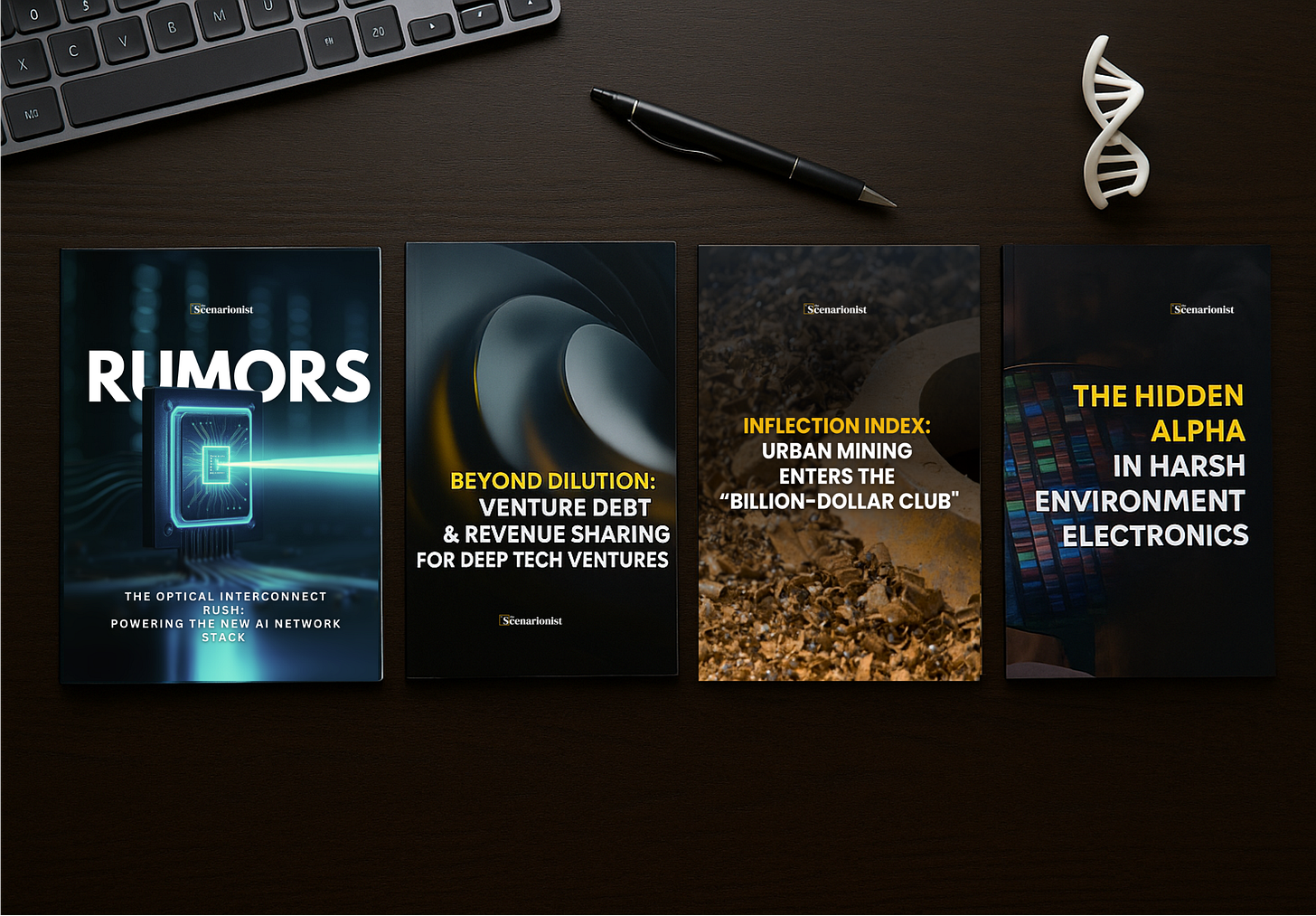Deep Tech Monthly in Review - October 2025
Field Notes from The Scenarionist. A Strategic Recap for Builders and Backers.
Dear Builders and Backers,
October was a month where deep tech got very concrete. Most of what moved forward had one thing in common: it could be installed, connected, certified, and operated inside existing power, compute, space, or industrial systems. That applied to small nuclear units trying to reach markets, to AI infrastructure trying to secure electricity, to space connectivity trying to behave like a utility, and to materials companies trying to sell into heavy industry.
Energy and compute kept getting closer. We saw small and factory-made nuclear designs presented as repeatable products, not one-off projects. At the same time, AI workloads kept asking for reliable megawatts, not just faster chips. That pushed attention to systems that deliver power and cooling right where the compute sits, and to locations — ports, industrial sites, sovereign hubs — that already have permits and grid capacity.
Space, connectivity, and defense became more operational. A “blockchain-to-orbit” signal, laser crosslinks going live, and space-as-utility framing all pointed to the same direction: space infrastructure is easier to finance and adopt when it looks like a service with uptime, diagnostics, and integration with civil/defense standards. Buyers want to know what it connects to, how it is serviced, and how fast it can be replicated.
Materials and industrial tech stayed important. Clean iron at scale, urban mining for rare earths, and electronics that survive heat or radiation are not flashy, but they solve bottlenecks that governments and large industrial buyers actually have. These technologies become more attractive when they come with qualification data, locked feedstock, and delivery plans.
Financing was present but not the main story. The month still showed that hardware teams need ways to pay for certification, first-article builds, and pilot runs without over-diluting — that’s why we published a guide on venture debt and revenue sharing — but the center of gravity in October was on the technologies themselves: nuclear you can ship, compute you can power, space links you can monitor, and materials you can qualify.
Enjoy the read,
— Nicola & Giulia
✨ For more, see Membership | VC Guides | Insights | Rumors | Exit
5 Key Takeaways from our October pieces:
From energy-constrained AI to factory-built fission and policy-sensitive materials, October showed that advanced technology scales fastest when it fits real infrastructure and real timelines.
Nuclear, space, and energy systems win when they’re copy-exact.
Factory-first fission, small reactors for industrial sites, and space links sold like public utilities all followed the same pattern: slow, capital-intensive categories move fast when the unit is standardized. Hardware that can be repeated, with known maintenance, known licensing, and known hosting sites, lets capital price delivery dates instead of betting on novelty. Replication — not reinvention — was the real unlock.Enabling layers — optics, rugged electronics, clean metals — hold unexpected pricing power.
Photonics that cut watts-per-bit, electronics that keep working under heat or radiation, and material streams that secure scarce inputs all sat closer to the bottlenecks than end-user applications. Because these layers lower operating risk and replacement cost, buyers accept higher prices and longer commitments. Owning the component that keeps the whole system running is still the most durable advantage.Certification and test capacity remain the financial choke point.
Several hardware classes could reach technical readiness but not revenue because they were waiting on safety or integration gates — UL (Underwriters Laboratories) for electrical safety, grid-tie for power assets, aerospace qualification, or GMP (Good Manufacturing Practice) for food and bio. October made it clear that financing has to be sequenced to those gates, not bolted on afterward. Teams that treat labs, inspectors, and interconnect calendars as scarce assets — and fund them — keep moving while others stall.Urban-mining lines have to look like process industry, not recycling experiments.
The facilities that will actually scale rare-earth and critical-material recovery are the ones with steady feedstock blending, in-line analytics, and traceable output specs — in other words, plants lenders can model the same way they model chemicals or metals. Variable scrap, vague quality, and one-off batches don’t clear underwriting.Space-as-a-service is pushing the ground segment to look more like telecom.
Buyers want SLAs (service-level agreements), remote diagnostics, backup-path planning, and full lifecycle visibility. That means ground hardware and software have to expose telemetry, fault reporting, and maintenance hooks that match existing NOC (network operations center) workflows. If it can be monitored and serviced like a network, it can be bought like a network.
The 3 Macro Trends That Defined October
The State Stepped In as a Venture Partner
October made it clear that governments aren’t just writing grants; they’re acting like anchor LPs and co-investors in critical stacks—power, chips-adjacent infrastructure, advanced materials. The tools were pragmatic: matching equity, credit guarantees, concessional loans, and demand-side anchors that derisk first deployments without crowding out private capital. The operating lesson is to treat policy like a design input: map your milestones to the instruments that unlock them (permitting, interconnect, certification), and plan for public audits and reporting from day one. Done well, “the state as VC” compresses time-to-market and improves cost of capital; done poorly, it adds paperwork without unlocking gates.Oncology Biotech Drew Deep, Targeted Funding
Across modalities, oncology teams that paired clear biomarker logic with clean trial designs found receptive investors. Antibody–drug conjugates, cell therapies, and precision small molecules all benefited when developers showed manufacturability, a realistic path to regulatory endpoints, and evidence that cost of goods won’t overwhelm value. The funding wasn’t indiscriminate; it favored programs with mechanistic transparency, robust safety plans, and partnership potential with established commercial engines. In short, money followed anti-tumor programs that could translate science into predictable development risk and a credible launch plan.Nuclear Graduated to the Public Ledger
Microreactor and SMR developers began testing public listings and related structures, shifting the conversation from technology novelty to balance-sheet strength and service SLAs. Investors responded to unit designs that look repeatable, with EPC wraps, spare-parts continuity, and heat/electricity contracts tied to real sites. For the category to endure on public markets, disclosures must keep pace: interconnect status, outage models, and O&M plans belong alongside nameplate output. The story that sells is reliability, not romance.
A Selection of Assets to Power Your Deep Tech Advantage
Capital is abundant; secrets are scarce. We hunt the latter so you can turn the former into compounding, high-margin positions.
The Scenarionist exists for investor, founders, and operators who think like engineers and act like contrarians. Every week, we ship precise, executable intel that turns first-principle insights into compounding moats—before the market even notices the opening.
In October, we released 17 original pieces across 4 streams:
Deep Tech Briefing — weekly operating intelligence on the events shaping deep-tech private markets.
Deep Tech Catalyst — tactical conversations with global experts; playbooks from lab to exit.
Capital Movements — where the money actually went + full round tracker.
Premium Analysis, Report and Playbooks — detailed playbooks on financing deep tech, building components for harsh environments, and scaling urban mining.
Missed a drop? The full load-out is below:
Deep Tech Briefing:
Edition 81 — First Blockchain-to-Orbit: Checks Beyond the (obvious) Hype Loop and more
A satellite relayed a signed blockchain transaction. Near-term use: a verifiable relay for outages or censorship and tamper-proof time-stamps. To become a product, it needs reliable coverage, predictable pass windows, cross-sat handoffs, and a low cost per message. Elsewhere: space services sold on SLAs, “open silicon” with real verification, geothermal units running for months, and hydrogen-electric systems at full scale.Edition 82 — Microreactors Go Public — Wall Street Joins the Power Stack & more
Microreactors moved onto public markets with factory-built plans. For data centers and industrial sites, the metric is uptime, not just cents per kWh. What matters: PPAs, interconnect queues, standard modules, and multi-year service terms. Weekly signals ranged from grid batteries and stainless rebar to in-house chips, rapid reentry capsules, and new public-private funding paths.Edition 83 — ⚛️ Fission Goes Factory-First; ⚡AI Chases Electrons; 🛰️ Space as Utility; 🔌 GPUs Need Grid Ties & more
Compute is megawatt-bound: power purchase, substation capacity, and heat limits now set performance ceilings. Space shifted to utility contracts with tasking, data delivery, and uptime written into SLAs; more subsystems moved in-house for mission assurance. Fission advanced from the factory to the field with repeatable units, while capital stayed selective and policy support firmed up.Edition 84 — 🪨 Clean Iron at Scale; 💰State as Shareholder; ⚡Compute Chases Megawatts; 🛰️ Laser Crosslinks Go Live; ✈️ AI-First Airframes & more
Governments took equity-style roles in compute, energy, and manufacturing, and onshore supply gained ground. Data-center growth is capped by electricity, interconnects, and cooling; laser crosslinks began serving real networks. Milestones: clean iron with offtakes, rare-earth refining stood up domestically, commercial hydrogen output, sodium-ion units shipping, and nuclear pitched as AI baseload. Common thread: copy-exact builds, reliable delivery, repeatable ops.
Deep Tech Capital Movements:
Edition 38 — Seeds surge in AI & defense; China’s launch sector lands a $336M D; Europe stacks new quantum/defense funds & more
Early rounds preferred AI/defense stacks that can be deployed and monitored, plus strategic launch in China and defense/quantum funds in Europe. Good indicator of where governments and corporates are leaning.Edition 39 — From GPUs to grid: efficiency layers fundraise big; autonomy goes field-ready; RNA & clinical keep pace
Money went to technologies that make existing compute cheaper to run, to autonomy that survives the field, and to bio platforms with clear clinical utility.Edition 40 — Power-to-compute leads; ADCs raise big; Autonomy stays bounded & more
Again, solutions that deliver power to compute and medical technologies with clear targets were prioritized. Bounded autonomy — with defined environments — stayed attractive.Edition 41 — Power-to-compute leads global raises; Autonomy funds real missions; Chemistry gets paid to go autonomous & more
This week confirmed that industrial chemistry and process tech can raise when they show autonomous operation and a buyer.
Deep Tech Catalyst:
EP 93 — Hardware for AI: The Data Center Math Investors Care About
What matters in AI infrastructure right now: power delivery that fits real sites, optics that lower watts-per-bit, cooling that works at density, and commercial terms tied to uptime. Shows how to make AI hardware legible to capital.EP 94 — Venturing into Distributed Energy Infrastructure: Bankability, Margins, and Moats
How to make distributed energy look financeable: standard modules, pre-sold offtake, clear service, and placement inside existing power/industrial nodes.EP 95 — Commercializing Quantum Computing: How to Design Sustainable Roadmaps Across the Quantum Stack
A step-by-step view of quantum commercialization: realistic timelines, workloads with buyers, and sequencing so hardware and software teams don’t overbuild. Useful for long-horizon compute founders.EP 96 — Scaling Deep Tech in Food: What Investors Look for
How to move from pilot to regulatory to GMP to real sales: name the partners, document yields, match production to cold-chain and windows. Same staged approach used in energy and industrial.EP 97 —From Bench to Margin: Startup Economics for Industrial Biotech
How to price, finance, and sell industrial biotech in small, certifiable steps — including how to survive the cash gap before approval.
Premium Analysis, Reports and Playbooks:
Beyond Dilution: Venture Debt & Revenue Sharing for Deep Tech Ventures
Shows how pairing equity with venture debt and revenue sharing funds certification, first-article builds, and early offtakes without surrendering control. Offers deal structures, lender expectations, and milestone gates to turn lab risk into priced covenants.
Inflection Index: Urban Mining Enters the “Billion-Dollar Club”
Maps why rare-earth recycling is on track for a $1B market by 2030—where moats form (yield, impurity budgets, QA), the red flags to avoid, and how enforceable offtakes make recycled magnets bankable inputs.
The Hidden Alpha in Harsh-Environment Electronics
Surfaces the overlooked “picks and shovels” for space, geothermal, and nuclear: components that survive heat, vibration, and radiation win sticky specs and long replacement cycles. A playbook for turning qualification data into durable margin.
The Optical Interconnect Rush: Powering the New AI Network Stack
Six startups, one direction: photonics moves bandwidth closer to accelerators to cut watts-per-bit and latency. We outline the architectures, likely buyers, and near-term tells—sampling timelines, serviceability at temperature, and vendor lock-in patterns.
10 Lessons from This Month in Deep Tech Ventures — October
Electrical capacity determined compute growth.
Operators that secured megawatt-scale supply, interconnection rights, and thermal management advanced deployments; those without committed power remained in planning.Standardized microreactors progressed faster than bespoke nuclear builds.
Units designed for copy-exact manufacturing, defined service intervals, and known licensing pathways were the only ones considered for integration into industrial and port facilities.Space connectivity was assessed as critical service infrastructure.
Links that provided stable performance, telemetry, and compatibility with civil/defense ground systems were prioritized over experimental payloads with unclear operating profiles.Optical interconnects emerged as the practical fix for data-center congestion.
Photonic links placed close to accelerators reduced energy per bit and latency, and designs that allowed in-rack maintenance were viewed as production-ready.Ruggedized electronics captured margin through reliability under stress.
Components qualified for high temperature, vibration, or radiation environments were priced above commodity parts because field replacement is cost- and time-intensive.Urban mining gained credibility when supply and off-take were contractually defined.
Recycling programs for rare and critical materials that showed feedstock control, test/quality pathways, and long-term buyers were treated as scalable industrial assets.Modular distributed energy systems won on deployment speed.
Pre-engineered packages with service documentation and pre-sold output were adopted more quickly at brownfield, power-enabled sites than custom engineered solutions.Quantum development was filtered through application readiness.
Roadmaps that tied hardware or software milestones to identified workloads and purchasers were advanced; generic performance roadmaps were not.Food-tech advanced when production and compliance were linearly specified.
Programs that laid out pilot production, safety/quality procedures, and confirmed demand windows secured earlier commercial traction than broad platform narratives.Certification and grid/safety approvals remained the primary working-capital choke point.
Hardware that met technical targets still could not be recognized as revenue until final approvals were completed, making milestone-linked financing instruments operationally necessary.
Final Thoughts
October was a simple reminder: deep tech moves faster when everyone can see where it fits.
If it’s clear where the system will live — a port, an industrial site, a data center, a government facility —
if it’s clear what it connects to — the grid, a rack, a satellite link, a plant —
and if it’s clear how the gap to final approvals is bridged — milestone-based financing, buyer prepayments, revenue sharing —
then the work becomes straightforward. Buyers can plan, lenders can model, and teams can build.
When those pieces are unclear, even strong technology has to wait.
We’ll keep tracking the places ready to host real hardware — energy-rich sites, national compute backbones, serviceable space networks — and we’ll keep sharing practical tools to turn working physics into working businesses.
See you soon!
— Giulia Spano, PhD & Nicola Marchese, MD
“Plans are nothing; planning is everything.”
— Dwight D. Eisenhower








